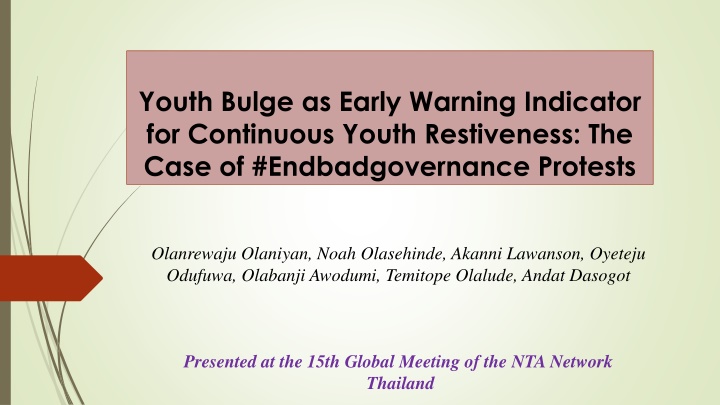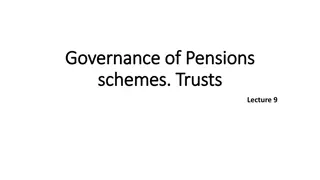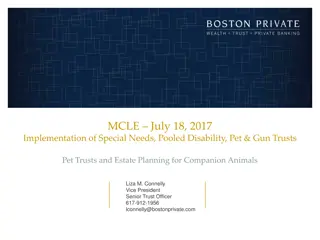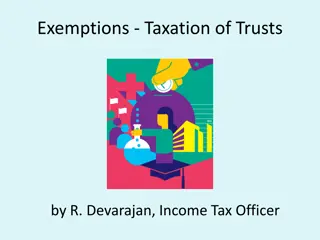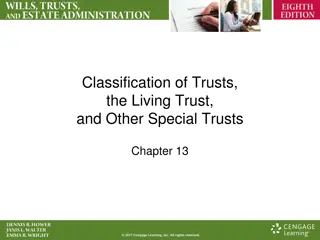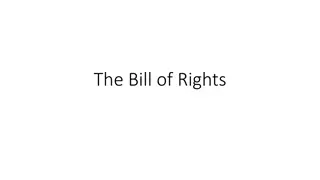Proposed Amendments and Violations in Charitable and Religious Trusts
Explore key amendments proposed for charitable and religious trusts, including provisions for registration cancellation and income computation. Discover specified violations leading to cancellation and controversies surrounding trust regulation.
Download Presentation

Please find below an Image/Link to download the presentation.
The content on the website is provided AS IS for your information and personal use only. It may not be sold, licensed, or shared on other websites without obtaining consent from the author.If you encounter any issues during the download, it is possible that the publisher has removed the file from their server.
You are allowed to download the files provided on this website for personal or commercial use, subject to the condition that they are used lawfully. All files are the property of their respective owners.
The content on the website is provided AS IS for your information and personal use only. It may not be sold, licensed, or shared on other websites without obtaining consent from the author.
E N D
Presentation Transcript
Youth Bulge as Early Warning Indicator for Continuous Youth Restiveness: The Case of #Endbadgovernance Protests Olanrewaju Olaniyan, Noah Olasehinde, Akanni Lawanson, Oyeteju Odufuwa, Olabanji Awodumi, Temitope Olalude, Andat Dasogot Presented at the 15th Global Meeting of the NTA Network Thailand
Youth groups are rising up everyday because Nigerian youth are tired. Tired of promises that amount to naught. Tired of a corrupt government and tired of recycled politicians. Tired of a failed and weak education system. Youth will [achieve change] by making their voices heard, going out to vote and making sure their votes count. World Bank (2010) Next Generations report
Introduction Nigeria is currently in the middle of demographic transition with fertility and mortality beginning to fall. This stage of transition leads to a situation where the age structure of the population is dominated by largely youthful population many of whom are either entering or will be entering into the working age in the next few years. The condition can have both advantages and disadvantages to the country In terms of realities of booms or doom. The doom happens because a large restless young people frustrated by lack of opportunity; increased competition for jobs, land, natural resources, and political patronage; cities can become increasingly unable to cope with the pressures placed on them; ethnic and religious conflict and radicalisation; and a political system discredited by its failure to improve lives. In order to prevent a doom position, the population structure can become a worthwhile indicator to use
#ENDBADGOVERNANCE These were series of mass protests in that occurred in Nigeria from 01 August to 10 August 2024, The protests were caused by: High Poverty and inequality among the people Staggering unemployment of large number of youths who are becoming frustrated Economic and political frustration of the people given the attitudes of the ruling elites COVID 19 pandemic and attendant suffering by the people who lost jobs, income and livelihoods Sudden increase in prices of essential goods including petrol, electricity tariff, VAT amid increased poverty and loss of livelihoods
Introduction What constitutes best practices in strategic early warning? Some points are fairly obvious (Cincotta and Leahy, 2007). Knowing who your main threats are in terms of strategic interests. Determining if they have a plausible intention to possibly act against us. Determining if they have the capability to do so.
Population: Nigeria 2050 401,314,997 2020 206,139,587 2010 158,503,203 1990 95,212,454 1970 55,982,142 1950 37,859,750 0 100000000 200000000 300000000 400000000 500000000
Population: Age Structure 100 1.83 1.82 2.09 3.68 4.71 7.55 90 16.98 18.9 21.5 25.8 28.48 80 30.59 70 29.18 34.89 60 33.91 34.01 50 39.36 33.39 40 30 52.01 44.38 42.5 20 35.47 28.48 28.47 10 0 North-Central North-East North-West South-East South-South South-West 0-14yrs 15-34yrs 35-64yrs 65+yrs
The Burge (Proportion of 15-34 years) 2050 35.1 2020 33.1 1990 31.7 1950 32.9 30.0 31.0 32.0 33.0 34.0 35.0 36.0
Age Profile of Per Capita Labour Income and Consumption in Nigeria, 2016 Profile of Economic Dependency, 2016 1.40 1.20 1.00 0.80 0.60 0.40 0.20 - 24 48 Consumption 2016 Duration of Lifecycle Surplus 34 72 12 15 18 21 27 30 33 36 39 42 45 51 54 57 60 63 66 69 75 78 81 84 87 0 3 6 9 90+ Labor Income 2016 Age Surplus Ended 62 Age Surplus Started 29
Economic Lifecycle Deficit, Nigeria 2016 1 Surplus N13.7 trillion 0.5 0 0 3 6 9 90+ 21 66 12 15 18 24 27 30 33 36 39 42 45 48 51 54 57 60 63 69 72 75 78 81 84 87 -0.5 Old Age deficit N1.63 trillion -1 Child deficit N43.93 trillion -1.5 -2 -2.5
Lifecycle Deficit in Nigeria, 2004 - 2016 0.80 0.60 0.40 0.20 - 0 3 6 9 21 78 12 15 18 24 27 30 33 36 39 42 45 48 51 54 57 60 63 66 69 72 75 81 84 87 90+ (0.20) (0.40) (0.60) (0.80) 2004 2016
Effective Consumers and Producers Total Population 206,139,587 Working Age 116,871,186 (57%) Non-Working Age 89,268,401 (43%) Out of Labour 36,579,292 (31%) Not in employment 21,764,617 (19%) Underemployed 22,942,003 (20%) Full employed 35,585,274 (30%)
Effective Consumers and Producers: Who are those out of labour force? Out of Labour force 36,579,292 (31%) Full Time School/Training 24,464,231 (67%) Full Time Household Duties 10,088,569 (28%) Aged/Retiree 2,022,835 (6%)
What are the warning signs? 14 High unemployment: Mechanical improvements in age-based dependency ratios cannot be a proxy for improvements in actual economic dependency ratios. NTA measure of dependency becomes crucial in measuring this. This surge in the relative size of the working age population when combined with the economic and political disenfranchisement that high unemployment reflects, can be a source of political and social instability that in turn worsens economic strain
Many youths are not working People Who Require Decent Jobs by State, 2022 2,200,510 1,976,624 2,500,000 1,705,183 1,398,369 2,000,000 1,213,163 1,013,598 1,500,000 805,412 796,237 755,336 694,000 679,601 600,955 592,942 559,091 1,000,000 438,660 437,953 429,869 410,096 407,548 406,639 400,312 391,942 343,536 335,867 313,643 279,271 274,692 267,581 252,678 246,853 241,367 227,683 222,021 213,785 171,493 148,326 500,000 22,883 0 ADAMAWA OSUN IMO TARABA NIGER KANO BAYELSA EBONYI KOGI KADUNA ENUGU FCT EDO KEBBI EKITI ONDO RIVERS YOBE BAUCHI OYO BENUE GOMBE BORNO NASARAWA CROSS RIVER AKWA IBOM DELTA PLATEAU OGUN SOKOTO LAGOS ABIA ZAMFARA KATSINA ANAMBRA KWARA JIGAWA Total Number of Nigerians who require decent jobs in Nigeria: 21,875,717 (2022) Source: Nigerian Population Projections and Demographic Indicators, 2020 by National Population Commission and Nigeria Labour Force Survey, 2022Q4
High Population growth rate and large number of children relative to the population 25 The Median Age 22 19 20 17 17 15 10 5 0 1950 1990 2020 2050
Disparities in Total Fertility Rate by States in Nigeria (MICS 2021 data) 7.6 8.0 7.4 6.6 6.5 7.0 6.4 6.1 5.9 5.7 6.0 5.3 5.3 5.2 4.9 4.8 4.6 4.5 5.0 4.4 4.3 4.2 4.2 4.1 4.0 3.9 3.7 3.7 3.7 3.6 3.6 3.6 3.5 4.0 3.4 3.3 3.2 3.2 3.2 3.1 3.1 3.0 3.0 2.0 1.0 0.0 Borno () Cross River Kaduna Kano Yobe Imo Oyo Osun Anambra FCT Abuja Kogi Ekiti Zamfara Lagos Enugu Kwara Abia Bayelsa Edo Akwa Ibom Ebonyi Taraba Gombe Katsina Rivers Ondo Delta Adamawa Plateau Jigawa Benue Kebbi Nasarawa Niger Ogun Sokoto Bauchi
Migration can be a big issue Rural and Urban Population in Nigeria, 1950 - 2020 2020 98,947 107,192.59 2010 89,554 68,948.89 1980 57,270 16,153.20 1950 34,301 3,558.82 0% 20% 40% 60% 80% 100% Urban population Rural Population Source: Drawn from United Nations, Department of Economic and Social Affairs, Population Division (2019). World Population Prospects 2019, Online Edition. Rev. 1.
Economic fundamentals are also in play: Savings and Financial Dividends Youth bulge and decreased dependency rates means that more resources are available to the working population that they wold need for their current status There must be policies that encourage and stimulates savings and investment of these surpluses. The country must prevent a way in which the excess funds are extravagantly spent on consumption with little or nothing for investment. If a high proportion of the returns on investment are made and saved outside the country, it might be counterproductive
What to do to prevent further Issues 20 Access to Quality Healthcare for those within the working age so that they can be optimally productive Every school age child must be in school and acquire basic education Investment in entrepreneurship and Skill Development Decent jobs to be provided within the capacity of the people's education Ensuring existence of enabling economic environment for private sector employment Ensure good governance and increased security through engagement of youth in productive activities
Summary Figures that serve as early warning for youth protests Total population of Nigerians in 2020: 206,139,587 Total number of Effective workers working to support the whole population: 35,585,274. Only 17.2 percent of Nigerians are working to support the 206 million people Total number of Nigerians looking for Decent Jobs: 21,875,717 (61% of the number of Nigerians that are working Total number of youths aged (15-34 years) in Nigeria looking for Decent jobs: 12,250,402 (56% of those looking for decent jobs in Nigerians are aged 15-34 years old)
Critical Questions to ask in resolving the early warning indicators Can the government (at all levels) provide jobs for everyone (44.7million Nigerians) looking for decent jobs? Can the economic system (capitalist or mixed) being used in Nigeria support this? How employable are these 21.9million to stay employable by themselves as entrepreneurs or by others in the private sector? How supportive are the business environment and economic infrastructure to entrepreneurship, SMEs and other private sector for them to provide employment opportunities Is a policy of consciously supporting youths (especially educated ones) to migrate to developed countries and send remittances a plausible options. (some countries depend on migrant remittances for their development)
Policy Options Deal with rising population and urbanisation with their attendant problems Quality quantity trade-off that breed responsible fertility and pro-family policies Invest in Human capital (health and education must be of the right quality, quantity and accessible at the right financial costs Employment must be guaranteed. Decent job is important. Opportunity must be given for individuals to grow rich before growing old. JOBS. JOBS. DECENT JOBS. Economic Governance including ease of doing business, infrastructure development transparency and accountability Youths have to be given more information. They must have capacity to shake the tables at some time Recognition that Security Issues have to be addressed frontally if the economy of the country will be sustained Maybe, given the diversity in population age structure of different regions of the country, restructuring should be prime of the country s development agenda A national census should be conducted as soon as possible for effective policy and planning towards sustainable development
Thank You Thank You 24
